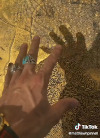About
Symmetries: The Beauty In Physics

Curvature Induced Symmetry
Symmetry-breaking transitions associated with the buckling and folding of curved multilayered surfaces which are
common to a wide range of systems and processes such as embryogenesis, tissue differentiation and structure formation in
heterogeneous thin films or on planetary surfaces have been characterized experimentally. Yet owing to the nonlinearity of the underlying
stretching and bending forces, the transitions cannot be reliably predicted by current theoretical models.
A generalized Swift-Hohenberg theory describes wrinkling morphology and pattern selection in curved elastic bilayer materials.
Swift-Hohenberg equation
By testing the theory against experiments on spherically shaped surfaces, Swift and Hohenberg found quantitative agreement with analytical predictions for the critical curves separating
labyrinth, hybrid and hexagonal phases. Furthermore, a comparison to earlier experiments suggests that the theory is universally applicable to macroscopic
and microscopic systems. Their approach builds on general differential-geometry principles and can thus be extended to
arbitrarily shaped surfaces.
Impasto
Impasto is a technique used in painting, where paint is laid on an area of the surface thickly, usually thick enough that the brush
or painting-knife strokes are visible. Paint can also be mixed right on the canvas. When dry, impasto provides texture; the paint appears
to be coming out of the canvas.
Origins
The word impasto is Italian in origin; in which it means "dough" or "mixture"; related to the verb impastare, "to knead", or "to paste".
Italian usage of impasto includes both a painting and a potting technique. According to Webster's New World College Dictionary, the root noun of
impasto is pasta, whose primary meaning in Italian is "paste".
 Curvature Induced Symmetry
Symmetry-breaking transitions associated with the buckling and folding of curved multilayered surfaces which are
common to a wide range of systems and processes such as embryogenesis, tissue differentiation and structure formation in
heterogeneous thin films or on planetary surfaces have been characterized experimentally. Yet owing to the nonlinearity of the underlying
stretching and bending forces, the transitions cannot be reliably predicted by current theoretical models.
A generalized Swift-Hohenberg theory describes wrinkling morphology and pattern selection in curved elastic bilayer materials.
Curvature Induced Symmetry
Symmetry-breaking transitions associated with the buckling and folding of curved multilayered surfaces which are
common to a wide range of systems and processes such as embryogenesis, tissue differentiation and structure formation in
heterogeneous thin films or on planetary surfaces have been characterized experimentally. Yet owing to the nonlinearity of the underlying
stretching and bending forces, the transitions cannot be reliably predicted by current theoretical models.
A generalized Swift-Hohenberg theory describes wrinkling morphology and pattern selection in curved elastic bilayer materials.
